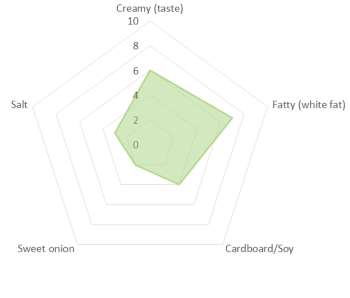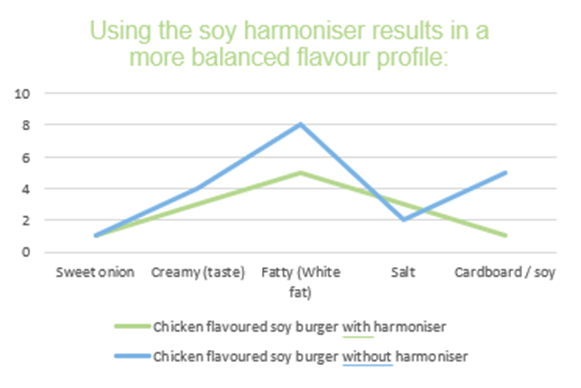Overcoming taste challenges in meat alternative products

Introducing Synergy’s soya harmoniser
Over the past five years, visibility and interest in plant-based diets has increased substantially, having gone from niche, to trend, to what the organisers of Veganuary this year called “a cultural shift”.
Having historically been quite a niche dietary requirement, many vegans had resigned themselves to sub-par tasting products and menu offerings when eating out of home, however with consumption of meat-alternative products on the increase – in many cases being driven by non-vegans – the focus is now on taste, with brands, own-label and foodservice all striving to improve the quality of their plant-based offering.
Unfortunately, this often easier said than done, and many alternative protein sources such as soya protein or pea protein can prove challenging bases to flavour. Using cutting edge analytical methods, we have been able to map out off-notes in cooked soya protein, allowing us to create natural flavours specifically designed for soya protein bases which undergo cooking.
Meat-free in numbers
There’s no denying that there’s interest in plant-based products and diets, you only have step out of your home (or go online!) to see that meat-free is everywhere, from blogs, to menu restaurants, to product launches, with even some of the most traditional menus and brands, but just how big is this market?
According to data from Mintel, the UK market for meat-free products in 2018 was valued at £740m, but is predicted to be worth £1.06bn by 2023. We’ve also seen the number of vegans in the UK grow – having quadrupled since 2014, to 600,000 however this only goes some way to explaining the growth in this category.

Central to the growth of meat-free has been the rise of the so-called flexitarians. Long-term vegans have most likely adapted their taste buds and culinary repertoires away from meat-like products, however flexitarians have not. As a result, these flexitarians have the desire to eat more plant-based meals, but may not have the ability to scratch cook an entire vegan meal. As a result, data from Kantar shows that 92% of plant-based meals and meal centres were eaten by non-vegans.
With so many of these products being eaten by non-vegans, taste is paramount as many of these consumers will naturally benchmark the products against the real deal! With more consumers than ever looking to reduce their meat intake, providing authentic flavour profiles is crucial.
In our quest for perfecting the flavour delivery in soya protein products, we have invested significant time and resource in understanding the base and how best to mask and flavour it.
Our method for understanding soya protein
As with most of our projects, we begin with descriptive analysis whereby our trained panellists identify the sensory characteristics of the protein and score them based on intensity. In the case of soya protein, the characteristics identified were creamy (taste), fatty (white fat), cardboard/soya, sweet onion and salt.

This sensory data is then supplemented by using Gas Chromatography (GC) to extract and identify all of the flavour compounds contained within the base product and map them against the descriptors, for example the creamy and fatty notes our panellists noted were determined to have come from the presence of Lauric acid, a compound known for its ‘waxy’ aroma.
By using this technique, we can truly understand the base we are working on and use this data to help guide our flavourists in tailoring natural flavours to either enhance or mask notes as required.
The effect of cooking on soya pieces
The development of flavour during cooking is almost universal amongst foodstuffs, with heat induced reactions such as the Maillard reaction accounting for much of the change in flavour profile.
Understanding the flavour profile of raw soya was one thing, but in order to create solutions which would be viable in commercial applications, we needed to understand soya protein as it would be presented to end consumers – in cooked form.
Once again using the same GC method, we compared the aroma composition of the cooked and uncooked soya pieces, identifying similarities and differences between the two.
Data from this work showed that cooking increased the presence of compounds typically associated with roasted, caramellic and smoky aromas – all of which are typically considered pleasant and can help mask the white fat or cardboard/soya notes identified in the base.
Rebalancing soya with the synergy soya harmoniser
Using this data, our flavour creation team can develop natural flavours which enhance the positive aroma compounds (roasted, caramelised) within the soya base, creating a neutral tasting soya improver which can be further flavoured (e.g. with meat flavours such as chicken or beef) as required.
The soya harmoniser effectively levels the perception of the base soya notes, allowing any additional flavours to start from a more level playing field.
The graph below shows the effect of the soya harmoniser combined with a standard chicken flavour, with panellists perceiving negative off-notes (such as white fat and cardboard) as being lower in the sample containing the harmoniser.

Synergy’s savoury toolkit
In addition to our soya harmoniser, we have a wide range of savoury capabilities which are ideal for any number of plant-based product applications, including savoury and meaty flavours and seasonings and authentic culinary pastes.
insights
